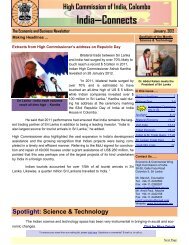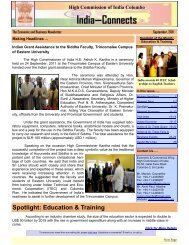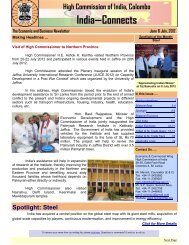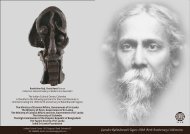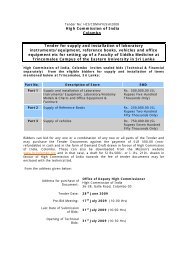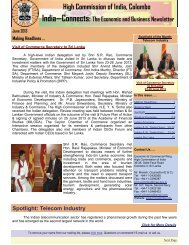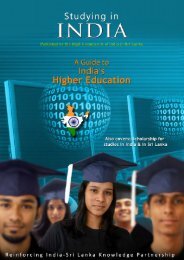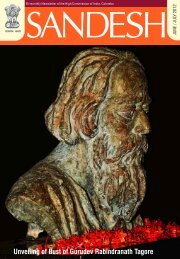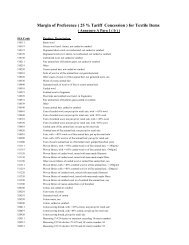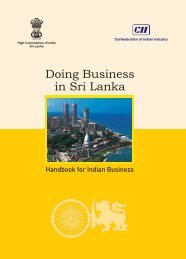Papers presented at the International Buddhist Conference, March ...
Papers presented at the International Buddhist Conference, March ...
Papers presented at the International Buddhist Conference, March ...
You also want an ePaper? Increase the reach of your titles
YUMPU automatically turns print PDFs into web optimized ePapers that Google loves.
NAGARJUNAKONDA:<br />
THE SITE OF INTERFACE BETWEEN INDIA AND SRILANKA<br />
[2ND- 4TH CE]<br />
YOJANA BHAGAT<br />
The above g<strong>at</strong>ha gives <strong>the</strong> architectural structures constructed like<br />
<strong>the</strong> Mahavihara, Chetiya, Thuparama, Thupa, Mahachetiya,<br />
Mahabodhi, Vapi and so on. This tradition of architectural<br />
construction was carried forward in <strong>the</strong> reign of kings like<br />
Duttagamini, Saddh<strong>at</strong>issa, V<strong>at</strong>tagamini, Voharika tissa,<br />
Mahanama and so on. The history carefully notes <strong>the</strong> constructions<br />
done in Srilanka from 3rd BCE and fortun<strong>at</strong>ely Sri Lanka also has<br />
few of those archaeological remains.<br />
Dr. Yojana Charandas<br />
Bhag<strong>at</strong><br />
Dr. Yojana Charandas Bhag<strong>at</strong> is <strong>the</strong> Coordin<strong>at</strong>or & Lecturer<br />
in Department of Pali, University of Mumbai (India). She has<br />
<strong>presented</strong> research papers <strong>at</strong> more than 15 intern<strong>at</strong>ional<br />
and n<strong>at</strong>ional<br />
conferences. More than 10 Research <strong>Papers</strong> on <strong>Buddhist</strong><br />
Art and Architecture and Pali Language had been published.<br />
She has written newspaper articles and conducted<br />
workshops for propag<strong>at</strong>ion of Pali. She is B. Arch. (Bachelor<br />
of Architecture) and M.A. in three different subjects namely,<br />
Ancient Indian Culture, Philosophy, and Pali. She has done<br />
Ph.D on <strong>the</strong> topic 'Impact of Vipassana Medit<strong>at</strong>ion on<br />
<strong>Buddhist</strong> Architecture' and pursuing ano<strong>the</strong>r doctor<strong>at</strong>e<br />
degree in Pali on <strong>the</strong> topic 'Mnemonics in Pali Liter<strong>at</strong>ure'.<br />
She has very good command in English, Hindi, Mar<strong>at</strong>hi and<br />
Pali.<br />
The cultural interface between India and Srilanka began in <strong>the</strong> 3rd<br />
BCE when <strong>the</strong>ra Mahinda alongwith Ittiya, Muttiya, Sambalam,<br />
Bhaddasala, Sumana samanera and Bhanduka landed on <strong>the</strong><br />
22<br />
Missakapabb<strong>at</strong>a and Sanghamitt<strong>at</strong>heri alongwith <strong>the</strong> Mahabodhi<br />
23<br />
and elevan khinasava bhikkhunis landed <strong>at</strong> Jambukolha .<br />
The architectural splendours constructed in Srilanka within years<br />
are very well noted in <strong>the</strong> Mahavamsa where <strong>the</strong> work of <strong>the</strong> king<br />
Devanampity<strong>at</strong>issa is described in <strong>the</strong> g<strong>at</strong>has.<br />
It is to be understood th<strong>at</strong> <strong>the</strong> interaction between India and<br />
Srilanka was not oneway. Monks from Srilanka flocked to India for<br />
pilgrimages and study and liter<strong>at</strong>ure sometimes mention <strong>the</strong><br />
numbers of monks coming to India.<br />
Unfortun<strong>at</strong>ely India donot have any liter<strong>at</strong>ure which could tell us<br />
about <strong>the</strong> students or monks who had come to India for study or<br />
constructed any vihara. Except for <strong>the</strong> inscriptions <strong>at</strong> Bodhgaya<br />
which talks about <strong>the</strong> monastery built for <strong>the</strong> sake of <strong>the</strong> monks<br />
25<br />
from Sinhala in <strong>the</strong> reign of King Samudragupta no<br />
archaeological evidence of <strong>the</strong> sites from Sinhala is found. Thus<br />
<strong>the</strong> history is silent especially when it comes to <strong>the</strong> flow from<br />
Srilanka to India.<br />
In such scenario <strong>the</strong> remains in <strong>the</strong> valley of Nagarjunakonda are<br />
very important. They are not only few of <strong>the</strong> remains of <strong>the</strong> proof of<br />
<strong>the</strong> architectural interaction between two countries but also has<br />
inscriptions which fur<strong>the</strong>r adds to our knowledge of prevalent<br />
Schools of Buddhism and <strong>the</strong>ir architectural preferences <strong>at</strong> th<strong>at</strong><br />
period. For in <strong>the</strong> Nagarjunakonda valley <strong>the</strong> remains of <strong>the</strong><br />
Culadhammagiri vihara of <strong>the</strong> Tampannidipa of <strong>the</strong> 2nd to 4th CE<br />
is found.<br />
This paper is an <strong>at</strong>tempt to study <strong>the</strong> site of Nagarjunakonda and<br />
find out more about <strong>the</strong> architectural practices of <strong>the</strong> said period in<br />
India and Srilanka. The paper is divided into two sections, <strong>the</strong> first<br />
section talks about Nagarjunakonda today and in 2nd -4th CE, its<br />
architectural splendor and importance. Most of <strong>the</strong> inform<strong>at</strong>ion in<br />
this section is <strong>the</strong> earlier work done on Nagarjunakonda by<br />
26<br />
different scholars ; it has been just compiled toge<strong>the</strong>r to give an<br />
idea about Nagarjunakonda. The second section is about <strong>the</strong><br />
Sinhala vihara <strong>at</strong> Nagarjunakonda, its architectural and<br />
inscriptional aspect along with <strong>the</strong> architecture prevalent in <strong>the</strong><br />
Deccan in th<strong>at</strong> period. Finally few observ<strong>at</strong>ions and questions are<br />
put forth. It is to be noted th<strong>at</strong> in this paper we are only<br />
concentr<strong>at</strong>ing on <strong>the</strong> architectural aspect and are not taking into<br />
consider<strong>at</strong>ion <strong>the</strong> sculptural art seen <strong>at</strong> Nagarjunakonda which is<br />
an independent entity altoge<strong>the</strong>r.<br />
Nagarjunakonda and its importance in <strong>the</strong> history of<br />
<strong>Buddhist</strong> architecture:<br />
<strong>the</strong> archaeological remains of <strong>the</strong> Nagarjunakonda valley brought<br />
into light <strong>the</strong> glorious past of <strong>the</strong> Indian history and architecture.<br />
This valley along with <strong>the</strong> remains of <strong>Buddhist</strong> monastic units,<br />
22<br />
Mahavamsa XIII-20, Mahavamsa and Mahavams<strong>at</strong>ika, Nalanda Edition 1971, pg. 286<br />
23<br />
Mahavamsa IX-23, Mahavamsa and Mahavams<strong>at</strong>ika, Nalanda Edition 1971, pg 362<br />
24<br />
Mahavamsa XX-17-20, , Mahavamsa and Mahavams<strong>at</strong>ika, Nalanda Edition 1971, pg 375<br />
25<br />
Glimpses of Srilankan Buddhism, Ahir D C, Sri S<strong>at</strong>guru Publ.,2000- pg. 204<br />
26<br />
H Sarkar, Elizabeth Rosen Stone, K Rama.<br />
45



